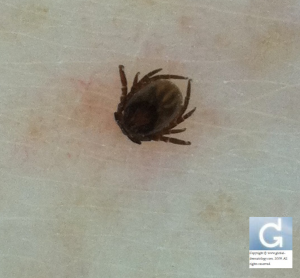How to avoid tick bites (prevention of Lyme disease (Borreliosis))
Dr Christophe Hsu – dermatologist. Geneva, Switzerland
- It is pleasant to walk in forests once the weather becomes pleasant. However, it is a good idea to avoid insect bites, especially ticks. In forests throughout the world, but especially in Europe and North America, these insects may carry bacteria causing Lyme disease (Borreliosis).
- To avoid insect bites while walking in the forest:
- Wear long-sleeved shirts and trousers. Clothing should be light-colored (light-coloured) so that the presence of ticks can be detected faster. Clothes can be sprayed with permethrin (which repels and kills insects).
- It is recommended to wear sock in which the trousers are tucked.
- In non-covered areas, apply a cream or a spray containing diethyltoluamide (DEET) at a concentration of 20 to 50%. A concentration of 8 to 10% is sufficient in children.
- If a tick bite is present, don’t worry. Go see a doctor as soon as possible to extract the tick. Do not try to suffocate, burn or apply irritants on the tick. If you decide however to extract the tick yourself, pull gently but steadily the tick with forceps or glove-protected hands. Do not forget to note the time and date of the tick removal.
- Lyme disease at its initial stage is not dangerous. It is easily cured by taking oral antibiotics.
- Not treating it can have serious consequences later because the disease can remain asymptomatic for a long time and reappear only when neurological, articular (joint) or cardiac (heart) signs appear.
Contributors:
Dr Christophe HSU – dermatologist. Geneva, Switzerland
Category : prévention de la borréliose - Modifie le 06.6.2010Category : prévention de la maladie de Lyme - Modifie le 06.6.2010Category : prévention des piqûres d'insecte en foret - Modifie le 06.6.2010Category : prévention des piqûres de tiques - Modifie le 06.6.2010Category : prevention of borreliosis - Modifie le 06.6.2010Category : prevention of insect bites when going in the woods - Modifie le 06.6.2010Category : Prevention of Lyme disease - Modifie le 06.6.2010Category : prevention of tick bites - Modifie le 06.6.2010Category : que faire lors de piqûre de tiques - Modifie le 06.6.2010Category : what do do with a tick bite - Modifie le 06.6.2010





